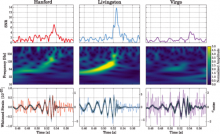
Abstract
On August 14, 2017 at 10:30:43 UTC, the Advanced Virgo detector and the two Advanced LIGO detectors coherently observed a transient gravitational-wave signal produced by the coalescence of two stellar mass black holes, with a false-alarm-rate of ≲ 1 in 27000 years. The signal was observed with a three-detector network matched-filter signal-to-noise ratio of 18. The inferred masses of the initial black holes are 30.5+5.7−3.0 Msun and 25.3+2.8−4.2 Msun (at the 90% credible level). The luminosity distance of the source is 540+130−210 Mpc, corresponding to a redshift of z=0.11+0.03−0.04. A network of three detectors improves the sky localization of the source, reducing the area of the 90% credible region from 1160 deg2 using only the two LIGO detectors to 60 deg2 using all three detectors. For the first time, we can test the nature of gravitational wave polarizations from the antenna response of the LIGO-Virgo network, thus enabling a new class of phenomenological tests of gravity.